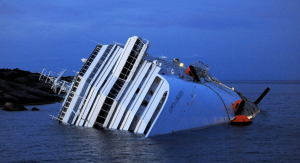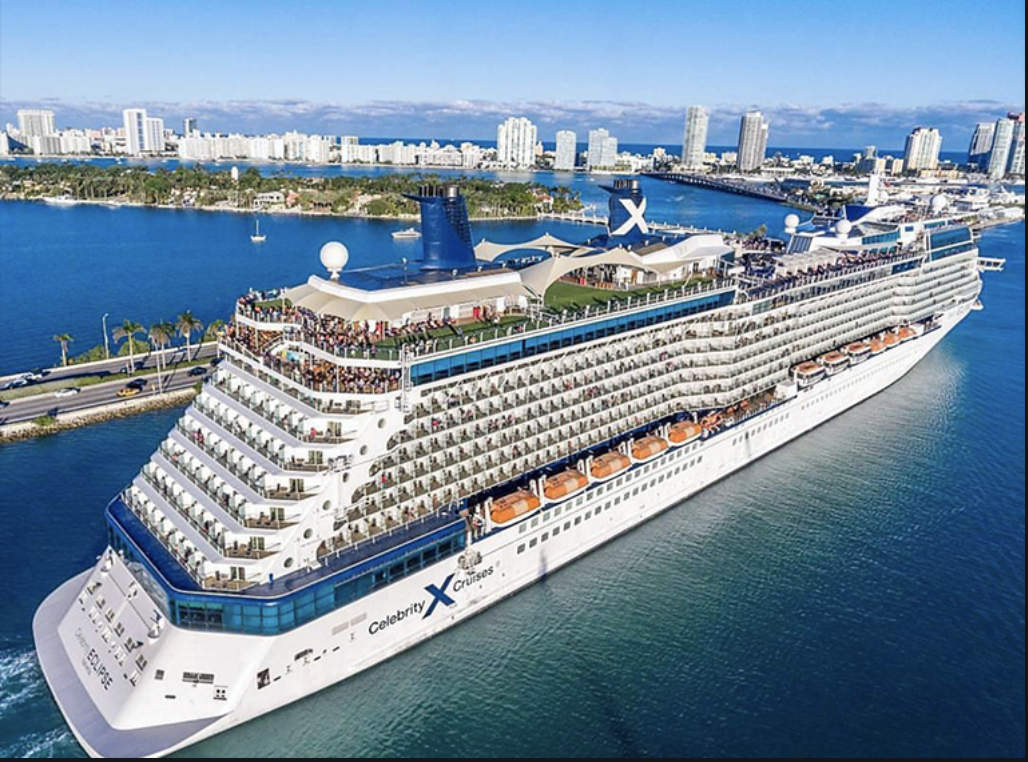Cruise ships are big—the ships are incredibly large and the number of worldwide passengers grows steadily. Many of the big ships are four football fields long, a half football field wide and almost a football field high (imagine the field standing upright on an end zone). Estimates for 2019 are that 20 million people went on a cruise. I’ll return to the size stuff at the end but, for most of this post, I’m going to focus on what people are encouraged to think they’re buying when they go on a cruise.
For the last five months or so, Celebrity Cruises, a branch of the Royal Caribbean cruise empire, has been running an ad for its “Sail Beyond” experiences. That they’re running an ad is not news. The soundtrack and the video in the ad are news. The sound track was taken from “White Rabbit,” written by Grace Slick and eventually released as a single record by Jefferson Airplane in 1967. For those who weren’t around fifty odd years ago or have forgotten, the song is an anthem of “tripping” by way of psychedelic or hallucinogenic drugs. Here are the lyrics of the original song:
One pill makes you larger, and one pill makes you small
And the ones that mother gives you, don’t do anything at all
Go ask Alice, when she’s ten feet tall
And if you go chasing rabbits, and you know you’re going to fall
Tell ’em a hookah-smoking caterpillar has given you the call
And call Alice, when she was just small
When the men on the chessboard get up and tell you where to go
And you’ve just had some kind of mushroom, and your mind is moving low
Go ask Alice, I think she’ll know
When logic and proportion have fallen sloppy dead
And the white knight is talking backwards
And the red queen’s off with her head
Remember what the dormouse said
Feed your head, feed your head
Here are the adapted lyrics used in the ad:
One pill makes you larger, and one pill makes you small
And the ones that mother gives you, don’t do anything at all
Go ask Alice, when she’s ten feet tall
When the men on the chessboard get up and tell you where to go
Remember what the dormouse said
Feed your head, feed your head
Alice in the ad is a takeoff on Alice in Lewis Carroll’s Adventures in Wonderland. Grace Slick acknowledged the influence of the classic book but interestingly, now in her mid-70s, she insists that the song was not about drugs but instead about self-discovery and the freeing of the imagination.
As striking as the music and lyrics are, the video stands out as well—so much so that, after viewing it and listening to it possibly a hundred times, I still watch and listen again. Judge for yourself.
http://https://www.youtube.com/watch?v=biI-NRvx0jY
In any case, why is a really big cruise ship company relying on lyrics and images that more or less promote a drug-enhanced trip? A paid spokesperson for the cruise company gave their answer:
The ad “follows a female protagonist on a voyage of discovery through a dream-like wonderland of world-class cuisine, cocktails, Eden-istic experiences and alluring accommodations, all on the brand’s newest ship, Celebrity Edge,” Celebrity said.
“Wonder Awaits is about bringing the experience of cruising with Celebrity to life in a dramatic, beautiful way,” said Peter Giorgi, chief marketing officer at Celebrity. “We wanted to show how unexpected moments, impeccable service and stunning design create a trip that is truly wonderful, and provides our guests with a break from reality, even for an instant.”
Let’s talk about the ship. It costs a billion dollars to build; it was launched late in 2018. Of course, like most cruise ships, it’s big—117,000 gross tons; 14 decks; it has just under 1500 staterooms—room for 2900 passengers and just over 1300 crew members. But what was intended to make this ship stand out was all the stuff they shoved into the 14 decks—dozens of places to eat, a round-the-clock casino; a spa which offers 124 different “treatments” and a “Magic Carpet” which extends out from the shell of the ship over the water and “flies” up and down from the level just above the water line to the very top of the ship. It’s not really magic but, if you have already believed everything they’ve told you, maybe you’ll think it is.
But what was designed to be the real icing on the cake was Eden—a three deck tall glass enclosed space inspired, according to the architect, by the Fibonacci sequence. [1] It features a garden of lush plants, physical environments that change from morning to night as the activities also change, exotic food dishes and cocktails, musicians and singers but, at the top of the list—the Edenists, a small group of performance artists responsible for creating an immersive, if not wondrous, environment. The action takes place throughout the whole space and is designed to draw passengers into the act. It’s perhaps closest to a circus.
A promotional video titled Eden Reveal seems to have been cooked up to make the plans all sound very high-minded. The narrator, the above-mentioned architect, begins with the Greek philosopher Epicurus and claims that Epicurus argued that: “life is about living, not living for life after death.” I’ll leave it for another day to talk about whether the philosopher’s ideas can be reduced to that one-liner. In any case, the architect then explains that they wanted “a space committed to nature and art allowing people to enjoy themselves.” We find out that the Fibonacci sequence was selected as a design principle because it illuminates patterns found throughout nature.
Meanwhile, the video opens with EDGE in center screen; a serpent makes its arrival and wraps itself around the letters; the D changes to a red apple and a bite is taken out of it. I guess you figured out the connection. But the narrator goes on to make it explicit–the space is intended to be chillful in the morning, playful in the afternoon and sinful at night.
In case you’re interested, here’s the video of Eden Reveal.
You can get an idea of what they were looking for when they were hiring Edenists, those who will be center stage during the “sinful” moments,by reading the original casting call:
Performers should be excellent storytellers with an engaging, welcoming and real presence; must be comfortable and excited to interact directly with audience members; grounded and real performers who can fully become their characters for an evening, and who are able to pull from their own experience on the spot in filling out a character and interacting with the audience; experience working in devised theatrical settings, environmental and immersive theater, and storytelling encouraged, but not required. Especially seeking: Edenists–Seeking fit, athletic and technically trained dancers with a strong background in expressionist and contemporary dance styles. Dancers should be comfortable performing barefoot. Additional performing skills–gymnastics, juggling, contortion, balancing, magic–a plus.
It seems like they got what they wanted. One industry publicist gushed about the Edenists—“a troupe of eight actors and actresses who embody the essence of Eden in their personalities – bring an unabashedly immersive vibe to Eden. Flitting around the space from visitor to visitor like birds pollinating flowers, the Edenists are the heart and soul of Eden. An Edenist may give you an interactive tour the first time you drop in, another may offer an impromptu juggling lesson, while a third might help you create a physical movement or gesture to represent your name.”
And what have passengers made of the whole experience? One travel writer gave a thumbs-down:“While I didn’t hate the ship, I didn’t love her either. … Just because Celebrity has sailed over the edge, doesn’t mean you have to follow.”It may well be that the new edgy ad is the follow-up to less than enthusiastic receptions by the traditional mainstay of the cruise industry—older folks (who are probably running out of their cruise years in any case). It appears that the cruise line is pivoting to a different younger audience. It may be what they had in mind all along and that the new ad is just catching up with the plan. And the plan: do what needs to be done. The ships have to be filled! Maybe the real tag line of the song wasn’t really: “Feed your head! Feed your head!” Instead, it was: “Fill the ship! Fill the ship!”
Keston Sutherland, a British poet, is a determined critic of the perverse impacts of advertising. In a 2004 article, Sutherland made three relevant points. First, advertising is pervasive in capitalist economies because it has replaced price competition as the principal weapon of profitability. Second, advertising’s remarkable success at selling the good life is often dependent on its absorption of what he refers to as “the counter-cultural stupefaction.” Third, the claim that the ad men are simply selling what people want is true enough but only because the condition of wanting has itself been degraded in advance by these same innocent marketing men into a stupefying adjunct of the culture industry.” Sutherland continually hammers home the idea that we have indeed been stupefied, made to lack any real sensibility and become numb.
Let’s go back to sailing over the edge! It concerns an issue that deserves to be taken very seriously–the safety of the cruise ships. A New York Times article from 2013 raised serious concerns. “The perils were most visible last year [2012] when the Costa Concordia, owned by the Carnival Corporation, which is based in Miami, capsized off the coast of Italy. The accident killed 32 people and revealed fatal lapses in safety and emergency procedures.“

An engineer told the reporter that, with big ships, any problem immediately becomes a very big problem. “The simple problem is they are building them too big and putting too many people aboard,” said a former safety manager for Norwegian Cruise Lines. He added, “The magnitude of the problem is much bigger than the cruise industry wants to acknowledge.”
This is not a new problem. In 1956, the Italian liner Andrea Doria was hit by another smaller ship
Soon afterwards, the Italian Marxist, Amadeo Bordiga, made a number of prescient observations (Weird and Wonderful Tales): “It is not only with ships that the mania of modern technology is oriented towards economising on the structure, using light metal sections with the pretext of ever more modern materials with miraculous strength, guaranteed more by insolent advertising and sleight of hand than the checks run by the bureaucratised laboratories and standards institutions. Just as with the construction of land vehicles, the ship produced by developed modern technology is not as solid as that of 50 years ago.”
He argued that, over time, architecture kills engineering. “Too many saloons, swimming pools, playing areas, too many decks above the waterline … too much weight and space put into the superstructure, that is the half skyscraper which stands above the waves, full of windows flooding out light where the luxury class has a good time. This all at the expense of the quickwork, the part in contact with the water, whose size and strength provide stability, flotation, course correction after wandering, resistance to attacks by the sea, collisions with mountains of ice…
The choice, then and now, is clear: “More or less vulgar luxury or the safety of the human lives on board, this is the anti-thesis.” That’s a big question!
[1]The Fibonacci Sequence is the series of numbers: 0, 1, 1, 2, 3, 5, 8, 13, 21, 34, … The next number is found by adding up the two numbers before it.


